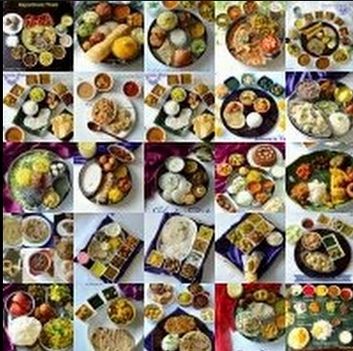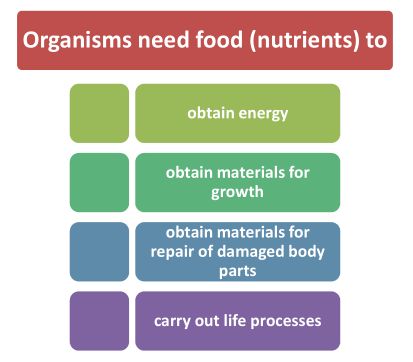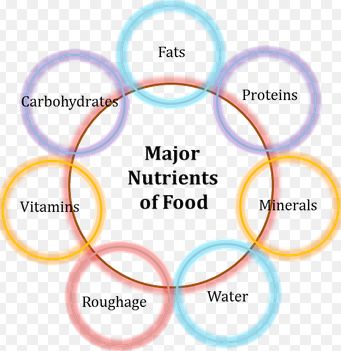- Books Name
- CBSE Class 6 Science Book
- Publication
- Param Publication
- Course
- CBSE Class 6
- Subject
- Science
Basic constituents of food
(a) Carbohydrates :
Carbohydrates are organic compounds of carbon, hydrogen and oxygen.
• They are the main source of energy in our body.
• One gram of carbohydrate yields about 4 kilocalories of heat energy.
• A major portion of our food consists of carbohydrates, e.g., rice, chapatis.
• If excess amount of carbohydrates are present in the body, they are converted into fats and stored under the skin and around various organs of the body.
• The carbohydrates in our food are obtained mainly from the plant sources like wheat, rice, maize, potato etc.
• Starch and sugars are the two carbohydrates which provide most of the energy to our body.
(b) Fats :
• Fats are composed of carbon, hydrogen and oxygen.
• They have a lower oxygen content than carbohydrates.
• They are very important sources of energy.
• One gram of fat yields 9 kilocalories of energy.
• A layer of fat under the skin helps to reduce the amount of heat loss from the body in cold weather conditions.
• Every fat molecule consists of three molecules of fatty acids and one molecule of glycerol.
• Fats are insoluble in water but soluble in organic solvents like alcohol, ether, benzene, etc.
• Fats are supplied to our body by different foods like butter, ghee, cheese, ground-nut etc. All the cooking oils (like ground-nut oil, coconut oil) provide us fats.
• Fats also help in forming of cell membranes and other organelles.
• They help in transportation of fat-soluble vitamins in our body.
(c) Proteins :
The name protein was coined by Berzelius in 1838.
• Chemically proteins are polymers of molecular units called as amino acids.
• The amino acids are linked together by a peptide bonds. There are about 20 amino acids that take part in the formation of proteins. The 20 amino acids are further divided into two groups :
• Essential amino acids : They are 10 in number. They are not synthesized in a human body and are obtained from food so they are called as essential amino acids. e.g., Methionine, Leucine and tryptophan.
• Non – essential amino acids : They are also 10 in number. They are synthesized in a human body & are thus termed as non – essential amino acids. e.g., Alanine, Asparagine, Aspartic acid and cystine.
• Pulses, peas, beans, nuts, cheese, milk are the important sources of proteins.
• They act as a structural components of cell. They are essential for growth and repair of the body.
• They help to catalyse various reactions occuring in our body.
• They play important roles as hormones, antibodies, etc.
• All the enzymes are made up of proteins.
• Haemoglobin, the respiratory pigment of animals is a conjugated protein composed of globin and haem(pigment).
(d) Vitamins :
Vitamins are organic compounds essential for the growth of the body. They are required by the body in very small quantities. Vitamins are classified into two types.
(A) Fat soluble Vitamins A, D, E, K. (B) Water soluble Vitamins B and C.
• These are obtained from fruits, cod liver etc.
• They keep the body healthy and prevent it from diseases. If the diet does not contain the required amount of vitamins, it results in vitamin deficiency diseases.
(e) Minerals :
• Human body requires about fifteen different kinds of minerals, e.g.-
• Calcium and phosphorus are needed for the growth of bones and teeth.
• Iron is needed for the formation of haemoglobin in blood.
• Iodine, sodium, potassium and zinc are necessary for a good healthy body.
• Meat, eggs, milk, green vegetables and fruits are rich in minerals.
• Minerals are required by the body in trace amounts and are essential for growth, repair and replacement processes. They form a major part of many body chemicals and tissues.
(f) Roughage :
Cellulose forms the fibre content in food and that fibre content is called roughage. Roughage keeps the digestive system in good working condition.
• It is a plant fibre found in vegetables, fruits, peas, beans, maize and in the barn which surrounds wheat grains.
• It absorbs water and poisonous waste from food during digestion. Food without roughage forms hard dry lumps of waste which get stuck in the gut causing constipation.
(g) Water :
The human body contains 70 % of water. It has no food value but it is still one of the essential components of living matter.
• Water performs the following functions in our body :
• It transports food materials within the body.
• It helps in the formation of urine and faeces.
• It regulates the body temperature.
• It is an essential part of blood and digestive juices.
- Books Name
- Class 6 Science Book
- Publication
- PathSet Publications
- Course
- CBSE Class 6
- Subject
- Science
INTRODUCTION
What do different Food Items contain?
- All living organisms such as plants and animals require food. So, food is essential for all living organisms.
- The food that we eat consists of different components or nutrients.
- NUTRIENTS are required for proper growth and healthy body function.
- The process by which we obtain food and utilize it for growth and development is called nutrition.
- Carbohydrates, proteins, fats, vitamins and minerals are essential components of food, these components are called nutrients.
- In addition, food also contains dietary fibers and waters
Nutrients: A nutrient can be defined as components that are needed by our body to grow, survive and carry on different daily activities.


Different Type of Food
Energy-giving food
Carbohydrates and Fats. Carbohydrates provide us instant energy. Fats are stored energy resources
Body-building food
Proteins are body-building food as they help in body growth and repair of damaged parts of the body.
Protective food
Vitamins and minerals are protective food as they protect us from many diseases. They give us resistance against disease causing germ
- Our food contains mainly five major kinds of nutrients namely vitamins, minerals, carbohydrates, proteins and fats. Additionally, food also contains water and dietary fibers/roughage and water which are also required by our bodies.

Fig. 1: Major nutrients of food

 Param Publication
Param Publication
 PathSet Publications
PathSet Publications
